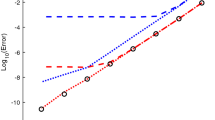Abstract
The concept of effective order allows for the possibility that the result computed in a Runge-Kutta step is an approximation to some quantity more general than the actual solution at a step point. This generalization is applied here to singly-implicit methods. The limitation that requires severe and inconvenient restrictions on the abscissae in the method is removed under this widening of the order requirement and all that is now needed is that the abscissae be distinct. Implementation questions, such as error estimation, stepsize change and dense output are also considered.
Similar content being viewed by others
References
K. Burrage, A special family of Runge-Kutta methods for solving stiff differential equations, BIT 18 (1978) 22–41.
K. Burrage, J.C. Butcher and F.H. Chipman, An implementation of singly-implicit Runge-Kutta methods, BIT 20 (1980) 326–340.
J.C. Butcher, The effective order of Runge-Kutta methods, in: Conf. on the Numerical Solution of Differential Equations, Lecture Notes in Mathematics, Vol. 109 (Springer, New York, 1969) pp. 133–139.
J.C. Butcher, On the implementation of implicit Runge-Kutta methods, BIT 6 (1976) 237–240.
J.C. Butcher, A transformed implicit Runge-Kutta method, J. ACM 26 (1979) 731–738.
J.C. Butcher, The Numerical Analysis of Ordinary Differential Equations (Wiley, New York, 1987).
J.C. Butcher, Towards efficient implementation of singly-implicit methods, ACM Trans. Math. Software 14 (1988) 68–75.
J.C. Butcher and J. Cash, Towards efficient Runge-Kutta methods for stiff systems, SIAM J. Numer. Anal. 27 (1990) 753–761.
J.C. Butcher and P. Chartier, A generalization of singly-implicit Runge-Kutta methods, Appl. Numer. Math. 24 (1997) 343–350.
J.C. Butcher and D.J.L. Chen, ESIRK methods and variable stepsize, Appl. Numer. Math. 28 (1998) 193–207.
J.C. Butcher and M.T. Diamantakis, DESIRE: diagonally extended singly implicit Runge-Kutta effective order methods, Numer. Algorithms 17 (1998) 121–145.
E. Hairer, S.P. Nørsett and G. Wanner, Solving Ordinary Differential Equations I, Nonstiff Problems, 2nd revised ed. (Springer, Berlin, 1991).
E. Hairer and G. Wanner, Solving Ordinary Differential Equations II, Stiff and Differential–Algebraic Problems (Springer, Berlin, 1987).
H.J. Stetter, Local estimation of the global discretization error, SIAM J. Numer. Anal. 8 (1971) 512–523.
H.J. Stetter, Analysis of Discretization Methods for Ordinary Differential Equations (Springer, Berlin, 1973).
M.A. López-Marcos, J.M. Sanz-Serna and R.D. Skeel, Cheap enhancement of symplectic integrators, in: Numerical Analysis 1995, Pitman Research Notes in Mathematics Series, Vol. 344 (Longman Sci. Tech., Harlow, 1996) pp. 107–122.
Author information
Authors and Affiliations
Rights and permissions
About this article
Cite this article
Butcher, J., Chartier, P. The effective order of singly-implicit Runge-Kutta methods. Numerical Algorithms 20, 269–284 (1999). https://doi.org/10.1023/A:1019176422613
Issue Date:
DOI: https://doi.org/10.1023/A:1019176422613



